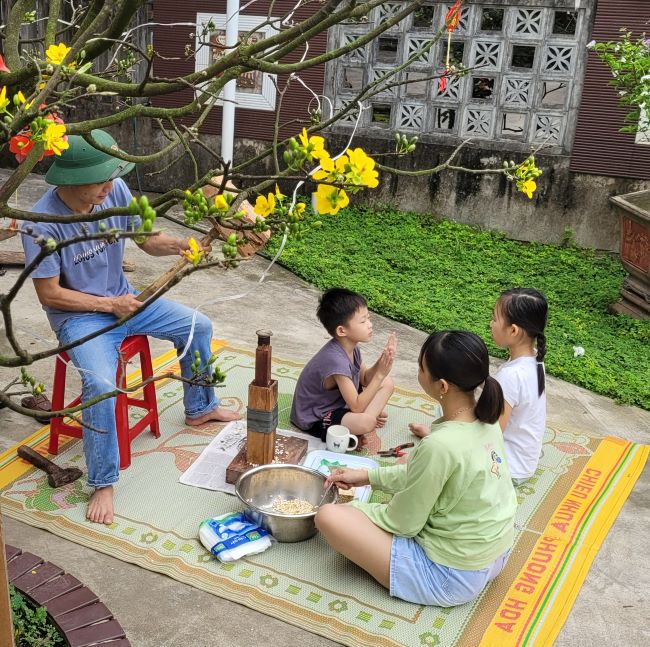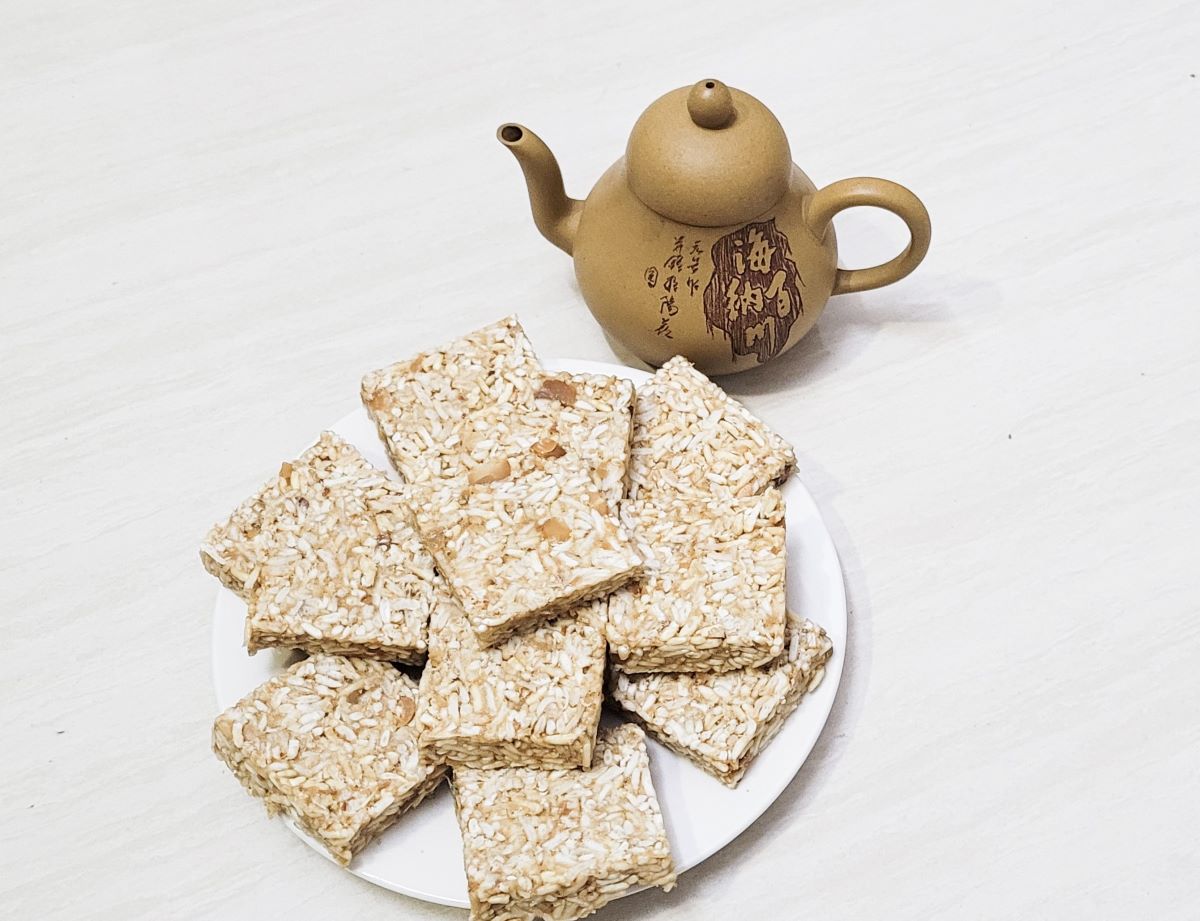The sticky rice exploded loudly!
Traditional cakes for Tet do not contain preservatives and can only be used for a dozen days or less, so from the 25th of December, people in the countryside start making cakes for offerings and eating. Dry cakes are made earlier because they can be kept for a whole month. Dry cakes originate from the thrifty nature of Vietnamese people, and are dry provisions that can be stored in the first month to be taken along as snacks when working in the fields.
In the old days, dry cakes were made from sticky rice roasted in a pan with firewood. The firewood had to burn steadily so that the smoke would not smell burnt on the popped grains. The roaster also had to skillfully stir and shake the pan so that the sticky rice would pop evenly and not burn. In the 1990s, people invented a popping pot, so that the sticky rice would pop fully and be evenly white.
Since the full moon of December, the blasting furnace has been bustling. Only a few communes in the area have one blasting furnace, so they have to work early and continuously until near Tet. The blasting furnace is essentially just a house with a canvas covering the chamber to catch the blasting grain. The blasting tool consists of an iron tube, called a blasting pot, with one end sealed and the other end a lid with a cocking lock. The blasting pot is equipped with a pressure gauge.
A batch of about 6 cans of sticky rice (condensed milk type) can make about 6 loaves of cake. The ratio between the sticky rice put in and the volume of the pot must always be fixed, to make it convenient to watch the pressure gauge. If you put too much, the sticky rice will be hard and not fully expanded, if you put too little, the sticky rice will easily burn.
The measured glutinous rice is poured into the iron pot, the lid is locked and placed on the charcoal fire. The pot is rotated regularly around the axis, the person rotating it is not allowed to rest. The heat causes the pressure inside the pot to gradually increase. After about six minutes, when the pressure gauge reaches the standard, the worker will use a hammer to tap the beak of the trigger to open the lid. The pressure difference inside and outside the iron tube causes the heated glutinous rice grains to expand and fly into the storage chamber.
A good pot roaster knows how to keep an eye on the clock and has a bit of intuition, depending on the type of sticky rice poured in, to know how to adjust the time. Only when the lid is opened can one know if the pot roast is done or not. Occasionally, a few pot roasts will be damaged due to overcooking, and the pot roaster must compensate with the sticky rice to make another pot roast for the customer.
Children are often assigned to go pop-popping because they are free, eager, and patient. Each child brings a portion of sticky rice in a large bag, marked with their name or a string. When they get to the pop-popping kiln, they have to sit there holding their own bag of sticky rice to avoid confusion and wait for their turn. If they run away for a moment, someone else will immediately jump in. Although each pop-popping batch only takes a few minutes, because of the large number of people, they sometimes have to wait for a whole morning, or even a whole day, to bring it back.

The most exciting moment was when the worker's arm stopped rotating the pot, raised the hammer to prepare to knock off the lid. Everyone held their breath, waiting to see if the popped rice was white and beautiful, or fluffy. A loud "boom" sound rang out, like a mustard flower gun shooting out thousands of white sticky rice flowers. Because of this sound, the villagers call popping rice "going boom". At the same time, the children jumped onto the canvas, each grabbing a handful to put in their mouths. The newly popped rice flowers coming out of the copper tube were warm and fragrant. The children sat waiting all day at the popping furnace without being hungry because of the fun and because they occasionally jumped in to grab a handful of popcorn to try.
The harder you pound, the better the cake.
Collect all the popped rice into a big bag and bring it home. But even after the popped rice has been made, you still have to wait for a mold to make it. The carpenters have already made this mold, so the whole neighborhood of twenty or thirty houses only has one mold. The mold is made of hard wood that is not susceptible to termites or warping over time, usually ironwood or ironwood. Four planks are joined together to form a hollow cylindrical box with a square cross-section of about 6 centimeters, with a band on the outside.
Spread the popped kernels out on a hot stove for a while to cool down, then mix with thick caramelized sugar water, add crushed ginger, fragrant banana oil, peanuts, and roasted sesame. Use your hands to mix well and put handfuls of popped kernels into the mold. Then put a wooden pestle that fits the mold. Use a wooden mallet to pound hard to compact each layer of popped kernels.
It takes two people to make the dry cakes. The person who puts the cotton into the mold needs to be skillful so that it doesn't fall out. The person who holds the mallet to make the cakes must be very strong and flexible. The harder the pounding, the harder the cake will be, and it won't break when sliced. A dry cake block, about two spans long, takes fifteen minutes to make.
Awakening the taste of old Tet
When eaten, the cake is sliced thinly and arranged on a plate to serve guests. The chewy cake has the rich taste of sticky rice, the sweetness of sugar, the spicy aroma of ginger and a little fat from sesame beans. Guests come to enjoy the cake with a cup of warm spring tea. The dry cake is named according to its nature: dry and chewy. Some places call it popped cake, because the cake is made from popped rice grains. Some places call it hoc cake, because the mold is like a compartment.
In the 2000s, when life became more hectic and people no longer spent as much time on Tet as before, the practice of making dried cakes was gradually forgotten. The number of kilns also decreased, then disappeared completely. The dried cakes that were thought to no longer exist were now reawakened.

But this past Tet, a rice-pouring kiln in my hometown (Dai Hao village, Trieu Dai commune, Trieu Phong district, Quang Tri province) resumed operations. I was excited to see people popping sticky rice, and it felt like I was returning to my childhood with the simple Tets of the past. The owner of the kiln said that at first he only intended to pop a few pots to make cakes in his house, but unexpectedly, people all over the area knew about it, so people brought sticky rice to rent him to pop, which was fun. It was also a way to share nostalgia with everyone, especially those who had been away from home for a long time, now returning to see the taste of the old Tet.
In the past, when wishing a happy new year to the people of my hometown Quang Tri, they were often treated to a dry cake to nibble on with a cup of tea. Almost every house had one, regardless of rich or poor, because it was a home-made dish made from local products. The cake was like the host's kind and neat heart. Nowadays, Tet does not require too much concern about eating well and dressing well like before. Guests are also not too concerned about what the host puts on the spring tea table anymore. When visiting on Tet, they often eat a piece for formality. But at that moment, the food must awaken the taste of spring, like the "home-made" dry cake.
(Posted in the special issue of Lao Dong Bac Mien Trung spring 2025)








